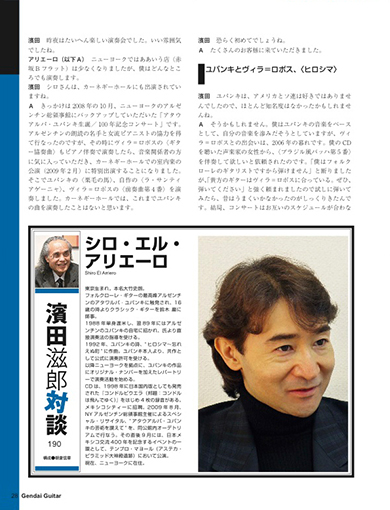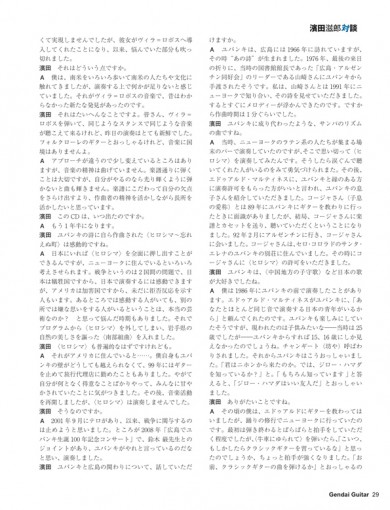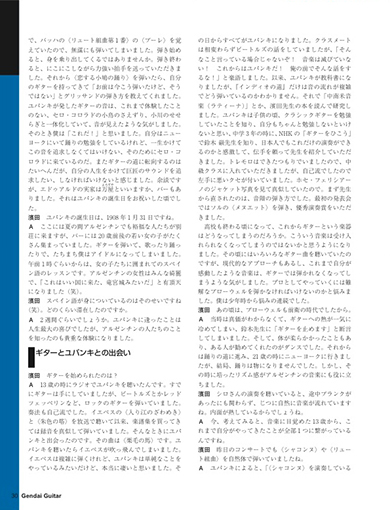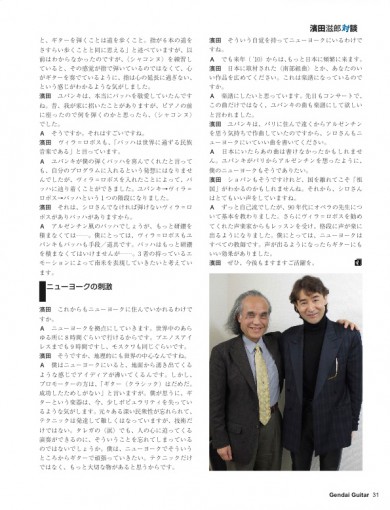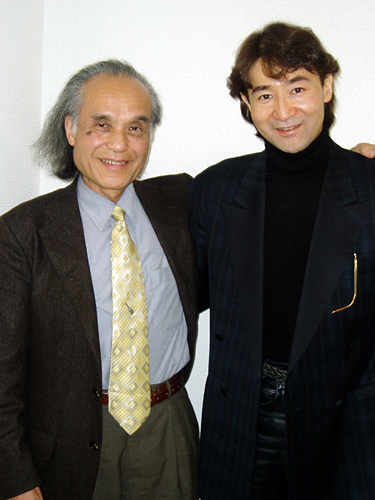A Talk With Jiro Hamada No.190
Guest : Shiro el Arriero
February Edition 2010
JiroLast night, your concert (at Akasaka B-flat in Tokyo, Nov.29, 2009) was marvelous. It was a very nice atmosphere, wasn’t it?
ShiroYes. The audience was so nice. I like to perform wherever people want to hear me.
JYou were invited to play at Carnegie Hall this year (February 2009) weren’t you?
SYes. Last year (2008) I performed the Villa-Lobos “Guitar Concerto” with an Argentine pianist in New York. The person who represents me at the moment heard this performance and liked it very much. That was what you might call the “trigger.” The program included works by Yupanqui, Villa-Lobos, J.S. Bach and my own compositions as well. Iwas so happy that this led to my performance of Yupanqui’s work at Weill Recital Hall. Before that, I don’t think his music had ever been performed at Carnegie Hall.
JYes. I expect it was the first time.
SAnd it was very successful.
Yupanqui and Villa-Lobos
JYupanqui was not well-known in the United States, was he? By the way – please tell me about this “trigger” that caused you to begin performing the music of Villa-Lobos.
SIt happened three years ago. A Soprano living in New York heard my CD and asked me to accompany her in a performance of Villa-Lobos Aria from “Bachianas Brasileiras V.” Her request came as a great surprise to me because, as I told her, I considered myself a guitarist of traditional South American folk music, and so would not be the right person to play for her.
JAnd what did she say to that?
SWell – she said “Your music is absolutely in the Villa-Lobos style. Please play for me.” So I tried to work from my old Villa-Lobos music sheet – which I was never able to play well when I was a kid, and suddenly found that I could play it very easily. Although that concert never did materialize – because of conflicts in our schedules – she had opened a door to what was issues I had been experiencing as a musician.
JPlease tell me about that.
SI had been traveling in South America and related very much to the people there. However, I always felt that something was missing in my music – something about South America which I was not able to express musically. And then I found what I was looking for in the music of Villa-Lobos. For me, a musician who felt so passionately about South America, this was an enormous discovery!
JThat is quite amazing. I have always felt that most classical guitarists played Villa-Lobos in the same fashion – I was always hearing same music. But your performance last night was completely different – absolutely “new.” I saw that there was no dividing line between classical music and folk music.
SAs far as the fingering goes, there is some difference, so I had to change my technique a little. However, I never changed the intention of the composer. It is, of course important to play the music as it is written, but it is also important to play own personality and thinking comes through when you play. Although I maintain respect for the composer, I prefer to demonstrate my own interpretive strength rather than perform in a manner which is not my style.
JWhen did you release your Caminante CD?
SEighteen month ago.
JI am truly inspired by “Hiroshima, The City I Shall Never Forget” which you composed to a poem written by Yupanqui.
SIf you live in Japan, you may use “Hiroshima” as a large selling-point. But if you live in New York, there are many factors to be considered, Wars occur between at least two countries or areas. When you perform music of this nature in the country of the “victim,” it has a powerful effect. However, if you perform it in the “attacking” country, you may find that the people have a completely different reaction. Could I call this true art? That was the question I asked myself and which prompted me to stop playing “Hiroshima.” I replaced it with “Suite Nambu” – also one of my compositions – and one which describes the beauty of Northern Japan. At that time, celebrating everlasting beauty was the true artistic theme for me.
JI think “Hiroshima” is everlasting beauty as well.
SAt that time – the end of the 90’s – I had a particular point of view which differed greatly from my feelings now, and it troubled me to such an extent that I was unable to perform “Hiroshima.” And so I left the musical scene for a year and half. I felt that I could never do justice to Yupanqui as long as I had this feeling. I needed to be much stronger than I was. SO I stopped playing and took a job in an office. During that time, I found myself surrounded by a lot of people who knew me well and who loved me. I suddenly felt as though I were being pampered inside a nice warm -room- and that wasn’t I wanted. So, in 2000, I returned to music. I probably would never have been able to stay away very long. And I was feeling stronger and more mature than I had before. Things began very nicely, but I still did not feel though I should perform “Hiroshima.”
JWhat caused you to perform “Hiroshima” again?
SWell, in 2008, I was asked to perform at the World Peace Memorial Cathedral in Hiroshima to celebrate the 100th anniversary of Atahualpa Yupanqui’s birth. Very exciting! At that time, I actually felt I could hear Yupanqui telling me “It’s time to play.”
JPlease tell me about the connection between Yupanqui and Hiroshima.
SIn 1966, during his second tour Japanese tour, Yupanqui visited Hiroshima. It was then that he wrote a poem. Later, in 1976, during his last tour of Japan, he gave the poem to Katsuhiro Yamasaki, a native of Hiroshima and a close friend to Yupanqui. When Mr. Yamasaki showed the poem to me, I was so deeply moved, I wrote the music in three minutes!
JIt is the Zamba rhythm – which seems to me to come directly from Yupanqui’s soul.
SI composed “Hiroshima” in 1991 at a time when I was performing in bars and restaurants in Queens (NY) where many Latin American people gathered. One day, I performed “Hiroshima” in one of those places, and when I finished, I saw many people crying.
Later, Eduardo Martinez, a good friend of mine who had introduced me to Yupanqui in 1989, suggested that I approach him directly for official permission to perform “Hiroshima.”
Yupanqui was very sick at that time, but his son, Roberto Chavero, took care of everything – acting as intermediary between his father and me. I later went to Argentina to receive the official document authorizing my composition – and so, “Hiroshima” was born in 1992.
JYupanqui loved Japanese folksongs very much, didn’t he?
SYes. That’s why I deliberately placed the traditional lullaby from Hiroshima in that music.
I actually played Yupanqui’s music for him at his summer home in Argentina. He had been told that there was a young Japanese guitarist who played his music exactly as he did – so, naturally, he was curious to see me. However, the young guitarist he saw looked more like a teenager – so much so, that he called me “Changuito” which means “Little kid.”
When I met him, he asked me if I had heard the name of Jiro Hamada, and I of course said I had. He then told me that Jiro Hamada was his best friend in Japan.
JI am honored – so happy to hear that.
SAt first, Yupanqui dod not seem so pleased with my performance of his music. My playing of “Los Ejes de Mi Carreta” must have seemed to him the performance of a little boy from Japan who had been trained by a classical guitar teacher, so he asked me to play a classical piece. I played Bach’s “Bouree BWV 996”, and he immediately became very interested and applauded enthusiastically.
My Spanish wasn’t very good at that time, so he wasn’t very impressed with my singing of his music. However, he seemed to have heard something in ma playing. I then performed his wonderful guitar solo “Danza de la Paloma Enamorada.” While I was playing, he suddenly said “Wait,” and picked up his guitar and proceeded to play as he had intended it should be played. The sound which flowed from his guitar was something I had never heard in my life. It was as if I could see the music moving away from that room and becoming part of the natural world outside. I remember thinking at the time that this is what I must learn to do. I must follow this incredible sound – however difficult it might be. I was willing to devote the rest of my life to it, if necessary.
I should mention that the mountain village where I met Yupanqui is called Cerro Colorado. It is the summer home of many wealthy Argentine families. Every night, the young girls would come and ask me to dance and play the guitar. I became a kind of celebrity. So instead of playing guitar, I danced, and they gave me Spanish lessons, It was surrounded by beautiful Argentine girls and learnt Spanish at the same time. I remember thinking – this is a very nice country – maybe I have found Shang-ri-la!
JThat’s why your Spanish is so good.
The Meeting With Yupanqui and Guitar
JNow please tell me about the early days when you began playing the guitar.
SWhen I was thirteen years old, I heard Yupanqui’s music for the first time on a radio program in Tokyo. At that time, I was a kind of “guitar kid” and playing the music of The Beatles and Led Zeppelin. But I was not very good. I didn’t even have a basic technique. Then one day, I heard Narciso Yepes’ interpretations of the music of Albeniz, and it aroused my interest in classical music. And then I heard Yupanqui, and it simply blew away everything I had known before. Although it seems as though Yupanqui’s music is very simple, it is actually quite difficult. From the moment on, I became a “Little Yupanqui.” When my friends spoke to me about Led Zeppelin, I would say “Hey, that kind of music is over – don’t even talk to me about it. I am Yupanqui. This is the beginning of my life.”
Yupanqui’s music then became my guitar “style,” and I was able to copy and play it even without the music. There was, however, a song called “Camino del Indio” which was so complicated that I couldn’t believe anyone could actually play it. Then I remembered that Yupanqui had taken classical guitar lessons as a child. So when I was sixteen years old, I began studying the classical guitar with Mr. Iwao Suzuki, one of the finest classical guitarists in Japan. When I visited him in his studio for the first time, he told me that I played well but that I seemed to have difficulty with my left hand and I would have to fix it. As a result of his instruction, it was only a matter of minutes before my left hand began to move in a very natural way. After my first year with Mr. Suzuki, I performed Fernando Sor’s “Minuet” in his students’ recital and was awarded the first prize.
However, by the time I was eighteen, I was worried that there might not be a future in guitar music. To be a real professional, I would have to play all kinds of repertoire, including contemporary works, which I didn’t like. I really didn’t think that I could make a living playing only Yupanqui’s music in Japan. So I stopped playing guitar and switched to another area in which I was also interested – Jazz Dancing. And that’s why I went to New York – not to be a guitarist, but a dancer. Today, the sence of rhythm I developed as a dancer is very helpful when I play Argentine folk music.
JEven though you have had a period when you did not play, your music sounds very spontaneous and natural to me. I expect that’s because your feeling for it is so deep.
SI now feel as though everything I have leaned since I was thirteen years old, has all come together.
JNothing could have been more natural than the way you performed Bach’s “Chaconne” and “Lute Suite” together with Yupanqui’s music at your concert last night.
SYupanqui once said that “Walking down a road is the same as playing guitar. My heart and fingers travel on six roads.” I am very much aware of his meaning when I play “Chaconne.” I now truly understand that the guitar is not played by the fingers alone. It must be played by the heart. The fingers are merely an extension of the heart.
JYupanqui truly loved Bach’s music. A long time ago, when he was in Japan, I invited him to my home in Tokyo. He sat down at the piano and played “Chaconne.”
SIs that true?
JYes. Villa-Lobos also had a great love for Bach. He used to say that Bach’s music was the highest form of folk music – one which connected the entire world.
SEven though Yupanqui liked my Bach interpretations, I didn’t include Bach’s music in my repertoire for many years. I came to Bach after I put Villa-Lobos in my programs. It was like climbing up the stairs of a building called Yupanqui – Villa-Lobos – Bach.
JThat’s wonderful. That’s obviously why you perform Bach and Villa-Lobos in that very special way which only you can do.
SThis is called “Bachianas Argentinas.” Of couese, I have to practice more and more in order to be able to perform Bach, Villa-Lobos and Yupanqui at the same time. To me, their music is like the finest pen. I would like to describe my beloved South America with the finest pen filled with the spirit of these three giants.
New York’s Stimulations
JWill you be living in New York long?
SI would like to. You can go to Buenos Aires in nine hours – and it’s the same to Moscow!
JGeographically, New York is the capital of the world, isn’t it?
SWhen I’m in New York, ideas seem to flow like water from a fountain. This happens only in New York. However, the situation for the guitar is not so good. I have heard from a famous concert promoter that he never has success with guitar concerts. This is a sad thing. But I believe the instrument has missed something important. It is not just an instrument which plays complicated themes. You can make people cry by playing Francisco Tarrega’s “Lagrima.” I would like to create my own music with this simplicity.
JThat’s why you are in New York.
SNext year (2010), I will be coming to Japan more often.
JI truly love “Suite Nambu,” one of your original compositions which I understand was inspired by the beauty of Northern Japan. I hope we will have more opportunities to listen to your music. Is it published in Japan?
SIt will be published in Japan soon. At last night’s concert, many people asked me to publish my works as well as those of Yupanqui.
JYupanqui wrote beautiful music in Paris….so Yupanqui’s Paris must be your New York, right?
SIf I was in Japan, I would not have been able to write “Suite Nambu.” I could write it because I was able to see my homeland from a distance.
JThe same can said of Chopin. Perhaps you can only realize the true beauty when you are far away.
By the way, you also have a fine voice, don’t you?
SI’m learning classical singing technique from Soprano (Kristine Kalina) who had asked me to accompany her. She is really a great voice teacher. New York is my teacher in many ways.
JI wish you all the very best for your future.

